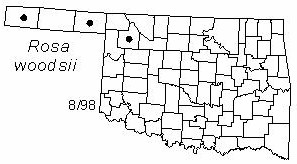Climbing vine or shrub to 2 m (6 ft) tall. Bark red-brown and furrowed. Twigs red-brown or gray, glabrous, terete; numerous straight to slightly curved spines. Leaves alternate, pinnately compound, 5-11 (typically 5-7); leaflets obovate, ovate, or elliptic; glabrous, often glaucous beneath; cuneate at base; obtuse at apex; margins serrate toward apex, entire near base; petiole glabrous; stipules adnate, pubescent with glandular teeth, 1-1.5 cm (0.4-0.6 in) long; rachis glabrous. Flowers in a corymb or solitary, borne on previous year's stems, glabrous; 1-2.5 cm (0.4-1 in) across, sepals 5, lanceolate, caudate-attenuate; petals 5, pink; styles persistent, not exserted; stamens numerous; flowers appear from June to August. Fruit a hip, 8-10 mm (0.3-0.4 in) diameter, globose to ellipsoid, red; nutlets numerous, shape variable, tan; fruits mature late August.
Distribution: Oklahoma and west Texas, north to North Dakota, British Columbia, south to Arizona, New Mexico. Uncommon.
Habitat: open prairies and woodland margins.
Comments: Rosa is the classical name of roses; woodsii honors the English botanist Joseph Woods (1776-1864), a student of roses.
Field identification: Woods' rose forms dense thickets.
Food uses: rose hips are an excellent source of vitamin C (60 times the concentration of lemons).
Medicinal uses: Cheyennes boiled the inner bark and roots to treat diarrhea and stomach aliments. The Arapahos made a tea from the bark to treat muscles.
Wildlife benefits: Provides cover for several species.
NWI status: UPL, FAC-.
Distribution in Oklahoma: 
BACK
NEXT
RETURN TO INDEX
Last update: 9/17/99
 Go to Oklahoma Biological Survey Home Page
Go to Oklahoma Biological Survey Home Page
 Disclaimer
Disclaimer